MetPublications
Showing 1 – 10 results of 355
Sort By:
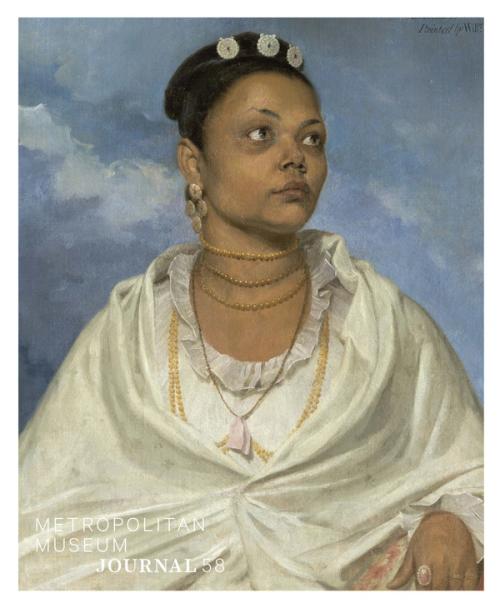 The Metropolitan Museum Journal is issued annually and publishes original research on works of art in the Museum’s collection. Highlights of volume 58 include an investigation of how boldly colored orange glass and enamels were produced at Qing imperial workshops; a rare portrait of Joanna de Silva, an Indian servant, by British artist William Wood in 1792; and the extraordinary discovery of a hoard of German silver cups and tankards hidden for more than two hundred years.Download PDFFree to download
The Metropolitan Museum Journal is issued annually and publishes original research on works of art in the Museum’s collection. Highlights of volume 58 include an investigation of how boldly colored orange glass and enamels were produced at Qing imperial workshops; a rare portrait of Joanna de Silva, an Indian servant, by British artist William Wood in 1792; and the extraordinary discovery of a hoard of German silver cups and tankards hidden for more than two hundred years.Download PDFFree to download Spanning three centuries of creativity, this volume in The Met’s How to Read series provides a peek into daily lives across Europe—from England, Spain, and France to Germany, Denmark, and Russia—through 40 exemplary objects. The featured furniture, tableware, utilitarian items, articles of personal adornment, devotional objects, and display pieces cover many aspects of European society and lifestyles, from the modest to the fabulously wealthy. The book considers the contributions of renowned masters, such as the Dutch cabinetmaker Jan van Mekeren and the Italian goldsmith Andrea Boucheron, as well as talented amateurs, among them the anonymous young Englishwoman who embroidered an enchanting chest with scenes from the Story of Esther. The works selected include both masterpieces and less familiar examples, some of them previously unpublished, and are discussed not only in light of their art-historical importance but also with regard to the social issues relevant to each, such as the impact of colonial slavery or the changing status of women artists.
Spanning three centuries of creativity, this volume in The Met’s How to Read series provides a peek into daily lives across Europe—from England, Spain, and France to Germany, Denmark, and Russia—through 40 exemplary objects. The featured furniture, tableware, utilitarian items, articles of personal adornment, devotional objects, and display pieces cover many aspects of European society and lifestyles, from the modest to the fabulously wealthy. The book considers the contributions of renowned masters, such as the Dutch cabinetmaker Jan van Mekeren and the Italian goldsmith Andrea Boucheron, as well as talented amateurs, among them the anonymous young Englishwoman who embroidered an enchanting chest with scenes from the Story of Esther. The works selected include both masterpieces and less familiar examples, some of them previously unpublished, and are discussed not only in light of their art-historical importance but also with regard to the social issues relevant to each, such as the impact of colonial slavery or the changing status of women artists.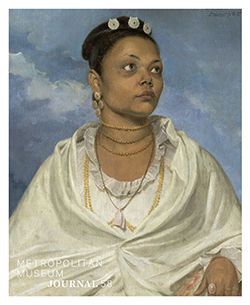 Download PDFFree to download
Download PDFFree to download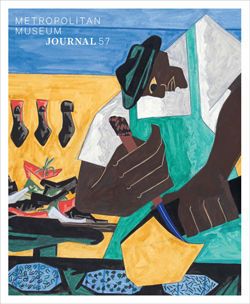 The Metropolitan Museum Journal is issued annually and publishes original research on works of art in the Museum’s collection. Highlights of volume 57 include essays on a crimson velvet “cloth of gold” associated with the Tudor dynasty; an exquisite pair of malachite torchères commissioned by the Russian Demidov family; and a drawing on muslin by Matȟó Nážiŋ detailing the Battle of the Little Bighorn in 1876.Download PDFFree to download
The Metropolitan Museum Journal is issued annually and publishes original research on works of art in the Museum’s collection. Highlights of volume 57 include essays on a crimson velvet “cloth of gold” associated with the Tudor dynasty; an exquisite pair of malachite torchères commissioned by the Russian Demidov family; and a drawing on muslin by Matȟó Nážiŋ detailing the Battle of the Little Bighorn in 1876.Download PDFFree to download The Metropolitan Museum Journal is issued annually and publishes original research on works of art in the Museum’s collection. Highlights of volume 57 include essays on a crimson velvet “cloth of gold” associated with the Tudor dynasty; an exquisite pair of malachite torchères commissioned by the Russian Demidov family; and a drawing on muslin by Matȟó Nážiŋ detailing the Battle of the Little Bighorn in 1876.Download PDFFree to download
The Metropolitan Museum Journal is issued annually and publishes original research on works of art in the Museum’s collection. Highlights of volume 57 include essays on a crimson velvet “cloth of gold” associated with the Tudor dynasty; an exquisite pair of malachite torchères commissioned by the Russian Demidov family; and a drawing on muslin by Matȟó Nážiŋ detailing the Battle of the Little Bighorn in 1876.Download PDFFree to download Every two years the fall issue of The Met's quarterly Bulletin celebrates notable recent acquisitions and gifts to the collection. Highlights of Recent Acquisitions 2020–2022 include the Mantuan Roundel by Gian Marco Cavalli, a recently rediscovered tour de force from the early Renaissance; the archive of photographer James Van Der Zee, one of the most celebrated chroniclers of Black life in New York City during the Harlem Renaissance; a pair of sculptures by the renowned contemporary American artist Robert Gober; Thomas Sully’s magisterial portrait of Queen Victoria; and Poussin’s Agony in the Garden, one of only two accepted works by the artist in oil on copper. This publication also honors the many generous contributions from donors that make possible the continued growth of The Met collection.Download PDFFree to download
Every two years the fall issue of The Met's quarterly Bulletin celebrates notable recent acquisitions and gifts to the collection. Highlights of Recent Acquisitions 2020–2022 include the Mantuan Roundel by Gian Marco Cavalli, a recently rediscovered tour de force from the early Renaissance; the archive of photographer James Van Der Zee, one of the most celebrated chroniclers of Black life in New York City during the Harlem Renaissance; a pair of sculptures by the renowned contemporary American artist Robert Gober; Thomas Sully’s magisterial portrait of Queen Victoria; and Poussin’s Agony in the Garden, one of only two accepted works by the artist in oil on copper. This publication also honors the many generous contributions from donors that make possible the continued growth of The Met collection.Download PDFFree to download This fascinating new look at the artistic legacy of the Tudors reveals the dynasty’s enduring influence on the arts of Renaissance England and beyond. Ruling successively from 1485 through 1603, the five Tudor monarchs brought seismic changes to England that reverberated throughout Europe. They used the arts to legitimize and glorify their tumultuous rule, from Henry VII’s bloody rise to power, through Henry VIII’s breach with the Roman Catholic Church, to the reign of the “Virgin Queen” Elizabeth I. With incisive scholarship and sumptuous new photography, this book explores the extreme politics and outsize personalities of the Tudors, and how they used art in their diplomacy at home and abroad. Tudor courts were truly cosmopolitan, attracting top artists and artisans from across Europe. At the same time, the Tudors nurtured local talent and gave rise to a distinctly English aesthetic, one that is forever connected to the myth and visual legacy of their dynasty. The Tudors reveals the true history behind a family that has long captured the public imagination, bringing to life their extravagant and politically precarious world through the exquisite paintings, lush textiles, gleaming metalwork, and countless luxury objects that adorned their spectacular courts.
This fascinating new look at the artistic legacy of the Tudors reveals the dynasty’s enduring influence on the arts of Renaissance England and beyond. Ruling successively from 1485 through 1603, the five Tudor monarchs brought seismic changes to England that reverberated throughout Europe. They used the arts to legitimize and glorify their tumultuous rule, from Henry VII’s bloody rise to power, through Henry VIII’s breach with the Roman Catholic Church, to the reign of the “Virgin Queen” Elizabeth I. With incisive scholarship and sumptuous new photography, this book explores the extreme politics and outsize personalities of the Tudors, and how they used art in their diplomacy at home and abroad. Tudor courts were truly cosmopolitan, attracting top artists and artisans from across Europe. At the same time, the Tudors nurtured local talent and gave rise to a distinctly English aesthetic, one that is forever connected to the myth and visual legacy of their dynasty. The Tudors reveals the true history behind a family that has long captured the public imagination, bringing to life their extravagant and politically precarious world through the exquisite paintings, lush textiles, gleaming metalwork, and countless luxury objects that adorned their spectacular courts.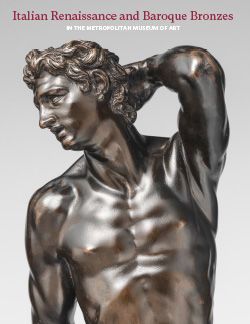 The revival of the bronze statuette popular in classical antiquity stands out as an enduring achievement of the Italian Renaissance. These small sculptures attest to early modern artists’ technical prowess, ingenuity, and desire to emulate—or even surpass—the ancients. From the studioli, or private studies, of humanist scholars in fifteenth-century Padua to the Fifth Avenue apartments of Gilded Age collectors, viewers have delighted in the mysteries of these objects: how they were made, what they depicted, who made them, and when. This catalogue is the first systematic study of The Metropolitan Museum of Art’s European Sculpture and Decorative Arts collection of Italian bronzes. The collection includes statuettes of single mythological or religious figures, complex figural groups, portrait busts, reliefs, utilitarian objects like lamps and inkwells, and more. Stunning new photography of celebrated masterpieces by leading artists such as Antico, Riccio, and Giambologna; enigmatic bronzes that continue to perplex; quotidian objects; later casts; replicas; and even forgeries show the importance of each work in this complex field. International scholars provide in-depth discussions of 200 objects included in this volume, revealing new attributions and dating for many bronzes. An Appendix presents some 100 more complete with provenance and references. An essay by Jeffrey Fraiman provides further insight into Italian bronze statuettes in America with a focus on the history of The Met’s collection, and Richard E. Stone, who pioneered the technical study of bronzes, contributes an indispensable text on how artists created these works and what their process conveys about the object’s maker. A personal reminiscence by James David Draper, who oversaw the Italian sculpture collection for decades, rounds out this landmark catalogue that synthesizes decades of research on these beloved and complex works of art.Download PDFFree to download
The revival of the bronze statuette popular in classical antiquity stands out as an enduring achievement of the Italian Renaissance. These small sculptures attest to early modern artists’ technical prowess, ingenuity, and desire to emulate—or even surpass—the ancients. From the studioli, or private studies, of humanist scholars in fifteenth-century Padua to the Fifth Avenue apartments of Gilded Age collectors, viewers have delighted in the mysteries of these objects: how they were made, what they depicted, who made them, and when. This catalogue is the first systematic study of The Metropolitan Museum of Art’s European Sculpture and Decorative Arts collection of Italian bronzes. The collection includes statuettes of single mythological or religious figures, complex figural groups, portrait busts, reliefs, utilitarian objects like lamps and inkwells, and more. Stunning new photography of celebrated masterpieces by leading artists such as Antico, Riccio, and Giambologna; enigmatic bronzes that continue to perplex; quotidian objects; later casts; replicas; and even forgeries show the importance of each work in this complex field. International scholars provide in-depth discussions of 200 objects included in this volume, revealing new attributions and dating for many bronzes. An Appendix presents some 100 more complete with provenance and references. An essay by Jeffrey Fraiman provides further insight into Italian bronze statuettes in America with a focus on the history of The Met’s collection, and Richard E. Stone, who pioneered the technical study of bronzes, contributes an indispensable text on how artists created these works and what their process conveys about the object’s maker. A personal reminiscence by James David Draper, who oversaw the Italian sculpture collection for decades, rounds out this landmark catalogue that synthesizes decades of research on these beloved and complex works of art.Download PDFFree to download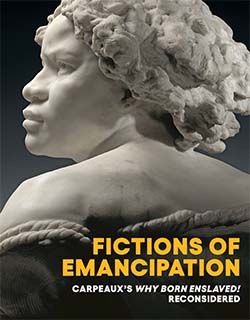 A critical reexamination of Jean-Baptiste Carpeaux's bust Why Born Enslaved!, this book unpacks the sculpture's engagement with—and defiance of—an antislavery discourse. In this clear-eyed look at the Black figure in nineteenth-century sculpture, noted art historians and writers discuss how emerging categories of racial difference propagated by the scientific field of ethnography grew in popularity alongside a crescendo in cultural production in France during the Second Empire. By comparing Carpeaux's bust Why Born Enslaved! to works by his contemporaries on both sides of the Atlantic, as well as to objects by twenty‑first‑century artists Kara Walker and Kehinde Wiley, the authors touch on such key themes as the portrayal of Black enslavement and emancipation; the commodification of images of Black figures; the role of sculpture in generating the sympathies of its audiences; and the relevance of Carpeaux's sculpture to legacies of empire in the postcolonial present. The book also provides a chronology of events central to the histories of transatlantic slavery, abolition, colonialism, and empire.
A critical reexamination of Jean-Baptiste Carpeaux's bust Why Born Enslaved!, this book unpacks the sculpture's engagement with—and defiance of—an antislavery discourse. In this clear-eyed look at the Black figure in nineteenth-century sculpture, noted art historians and writers discuss how emerging categories of racial difference propagated by the scientific field of ethnography grew in popularity alongside a crescendo in cultural production in France during the Second Empire. By comparing Carpeaux's bust Why Born Enslaved! to works by his contemporaries on both sides of the Atlantic, as well as to objects by twenty‑first‑century artists Kara Walker and Kehinde Wiley, the authors touch on such key themes as the portrayal of Black enslavement and emancipation; the commodification of images of Black figures; the role of sculpture in generating the sympathies of its audiences; and the relevance of Carpeaux's sculpture to legacies of empire in the postcolonial present. The book also provides a chronology of events central to the histories of transatlantic slavery, abolition, colonialism, and empire.